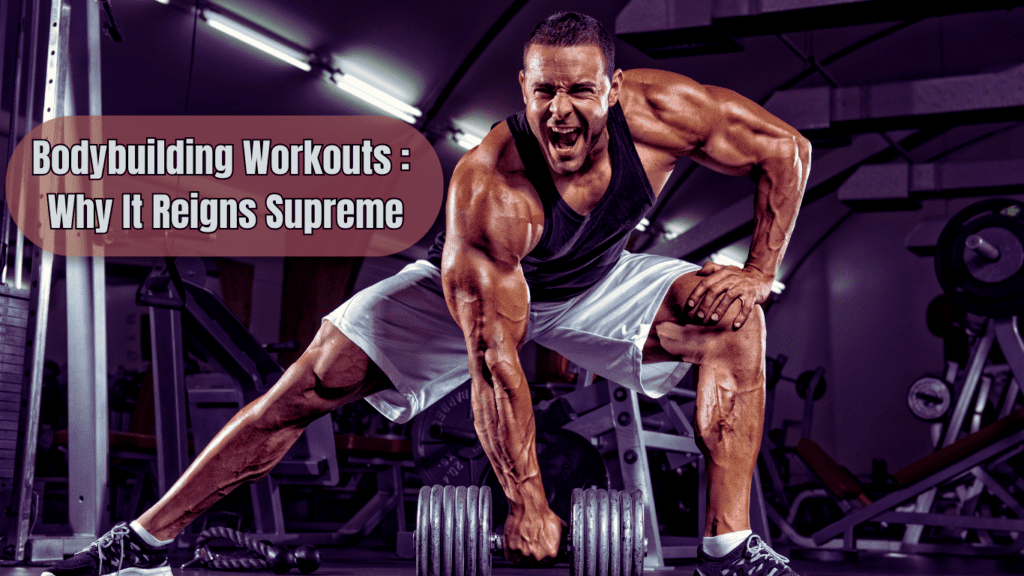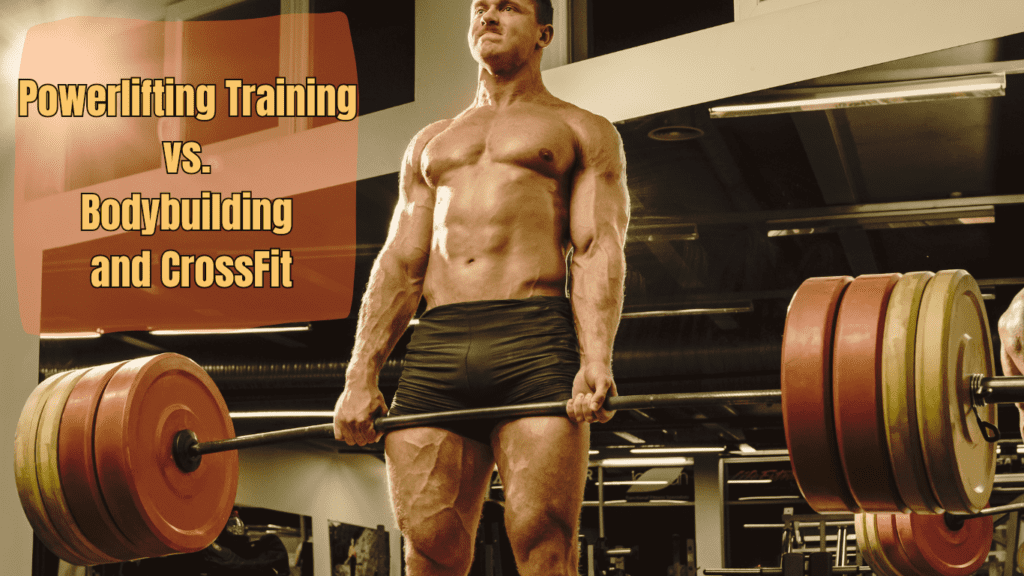Introduction to the Benefits of Calisthenics vs Weightlifting
In this article, we’ll explore the powerful benefits of calisthenics vs weightlifting to help you find the perfect fitness routine that transforms your goals into reality!
When it comes to fitness, there’s a never-ending debate: calisthenics or weightlifting? Both methods have stood the test of time as effective ways to build strength, enhance health, and improve overall fitness. But if you’re asking yourself which one is right for you, you’re not alone. The choice between these two approaches often depends on your personal goals, lifestyle, and preferences. That’s why understanding the benefits of calisthenics vs weightlifting is essential to making an informed decision.
This article will provide a detailed comparison of the benefits of calisthenics vs weightlifting, helping you understand how these two training styles differ and how they can be used to reach your fitness goals. Whether you’re aiming for functional strength, muscle definition, or just looking to stay active, this article will guide you through everything you need to know.
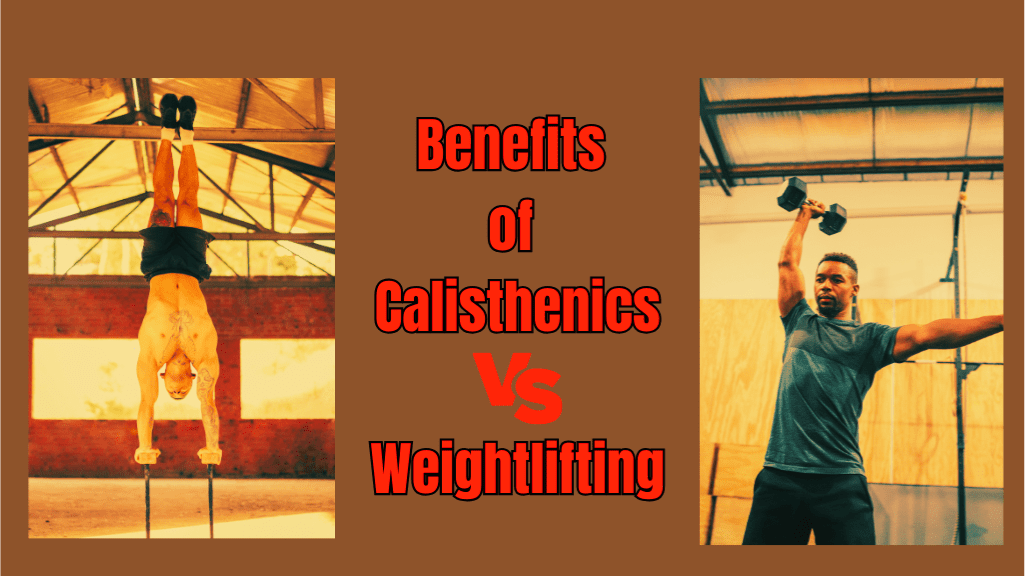
What Do Calisthenics and Weightlifting Mean? ( Benefits of Calisthenics vs Weightlifting )
Before diving into the specifics, it’s important to have a clear understanding of what calisthenics and weightlifting involve.
- Calisthenics is a form of exercise that relies on your body weight for resistance. Think of exercises like push-ups, pull-ups, squats, lunges, and planks. The beauty of calisthenics lies in its simplicity and accessibility—you don’t need expensive equipment or a gym membership. It’s a style of training that emphasizes natural, functional movements and allows you to work out anywhere, whether it’s in a park, at home, or even in a small apartment.The goal of calisthenics isn’t just to build muscle—it’s also about improving overall body control, flexibility, and endurance. Many advanced calisthenics moves, like muscle-ups or handstand push-ups, require immense skill and strength, making it a challenging and rewarding form of exercise.
- Weightlifting, on the other hand, involves the use of external resistance, such as dumbbells, barbells, kettlebells, or machines, to build strength and muscle. It’s a more structured and progressive approach to training, often focusing on specific muscle groups and allowing for precise adjustments to resistance.With weightlifting, the emphasis is on progressive overload, which means gradually increasing the weight or resistance over time. This makes it a great option for those looking to build muscle mass, increase strength systematically, or even train for athletic performance. Weightlifting is typically done in a gym or with a well-equipped home setup, and it offers a wide range of exercises to target different areas of the body.
Subscribe And Get Our Free E-Book:Unlocking The Power Of Nutrition-Supplements, Substitutes, and Superfoods!
Why Is the Comparison Important? ( Benefits of Calisthenics vs Weightlifting )
The debate surrounding the benefits of calisthenics vs weightlifting isn’t about picking a “winner.” Instead, it’s about understanding what each method offers and how they align with your unique goals. For example, are you looking for a minimalist workout you can do anywhere, or do you prefer the structured, measurable progress of lifting weights?
- If you’re someone who values convenience, calisthenics may be more appealing. The freedom to work out without equipment or gym memberships makes it highly accessible.
- On the other hand, if you’re focused on building muscle mass or increasing raw strength, weightlifting may be the better choice, as it allows for more precise progression and customization.
Another important factor to consider is how these methods fit into your lifestyle. Do you travel frequently and need a portable workout routine? Or do you enjoy the focused environment of a gym? By understanding these key differences, you’ll be better equipped to make the best choice for your fitness journey.
How Calisthenics vs. Weightlifting Align with Different Fitness Preferences
| Lifestyle/Preference | Calisthenics | Weightlifting |
|---|---|---|
| Fitness Environment | Ideal for small spaces, parks, or on-the-go travel. | Best in a gym or well-equipped home gym with necessary weights. |
| Goal-Oriented Focus | Great for improving flexibility, body control, and mobility. | Primarily focused on building muscle mass, strength, and hypertrophy. |
| Progress Tracking | Progress is tracked through mastery of new moves and skill development (e.g., from knee push-ups to full push-ups). | Progress is tracked by incremental increases in weight, reps, or sets. |
| Community/Support | Can be done alone or with a like-minded bodyweight training community. | Typically done in gyms with access to professional trainers, classes, or lifting partners. |
| Customization for Injury Recovery | Less stress on joints and bones; great for gradual recovery and low-impact rehabilitation. | Requires careful attention to form to avoid strain; useful for controlled strength development post-injury. |
| Adaptability | Highly adaptable; exercises can be modified for all fitness levels. | More structured; best suited for individuals who are comfortable with following a regimented routine. |
| Social Aspect | Less interaction in traditional fitness settings. Can be solitary or involve small workout groups. | Often more social, especially in gym environments with training partners and group activities. |
| Time Efficiency | Quick, high-intensity workouts can fit into busy schedules. | Requires more time, especially for warming up, setting up, and completing sets. |
Benefits of Calisthenics vs Weightlifting: What This Article Will Cover
In the sections that follow, we’ll break down the benefits of calisthenics vs weightlifting, diving deeper into how each method supports strength, endurance, mobility, and overall health. Whether you’re new to fitness or simply looking to switch up your routine, this article will provide clear insights to help you decide which approach—or combination of both—works best for you.
Calisthenics vs Weightlifting Video
What is Calisthenics? Benefits of Calisthenics vs Weightlifting Explained
Calisthenics is a form of exercise that focuses on bodyweight movements to build strength, endurance, and flexibility. Unlike weightlifting, which uses external resistance such as dumbbells and barbells, calisthenics utilizes the natural resistance provided by your own body. This makes it a versatile and accessible fitness method suitable for people of all fitness levels.

Definition of Calisthenics
At its core, calisthenics involves bodyweight exercises performed in a way that engages multiple muscle groups simultaneously. These exercises range from simple movements like push-ups and squats to more advanced feats such as muscle-ups and human flags. The beauty of calisthenics lies in its simplicity, offering a full-body workout without the need for expensive equipment or a gym membership.
Whether you’re a beginner or an advanced athlete, calisthenics has something to offer. From building foundational strength to mastering impressive skills, this approach caters to a wide range of fitness goals.
Key Characteristics of Calisthenics
One of the defining aspects of calisthenics is that it requires no equipment. Unlike weightlifting, which relies on barbells and dumbbells, calisthenics allows you to train anywhere, whether it’s a park, your living room, or a small space in your home. This makes it an ideal option for those who travel frequently or prefer exercising outdoors.
Additionally, calisthenics exercises can be tailored to suit all fitness levels. Here are some key characteristics:
- Beginner-Friendly Movements: Simple exercises such as bodyweight squats, push-ups, and lunges are perfect for those just starting out. These movements help build a solid foundation in strength and endurance.
- Advanced Movements: As you progress, you can challenge yourself with more complex exercises like muscle-ups, handstands, and human flags. These movements require greater control, balance, and strength, making them ideal for those looking to push their limits.
The versatility of calisthenics means it can be customized to focus on specific muscle groups or provide a full-body workout. Whether you prefer working on your upper body, core, or legs, there’s a wide range of exercises to meet your needs.
Brief History of Calisthenics
The origins of calisthenics can be traced back to ancient Greece, where bodyweight training was used to prepare soldiers for battle. Early Greek warriors relied on bodyweight movements to enhance strength, agility, and endurance. Over time, this training method evolved and was adopted by various groups, including gymnasts and military personnel.
Throughout history, calisthenics has been used as a versatile and effective method of fitness training. From ancient civilizations to modern-day fitness enthusiasts, its ability to develop functional strength has made it a staple in exercise routines across the globe.
In the 20th century, calisthenics became increasingly popular within military training regimens and gymnastics. Soldiers and athletes alike utilized bodyweight exercises to improve performance, flexibility, and overall fitness. This practice has only grown in popularity in recent years, as more people recognize the benefits of calisthenics for general health and athleticism.
Examples of Calisthenics Workouts
One of the most appealing aspects of calisthenics is the ability to create dynamic and effective workouts without the need for weights or machines. Here are some common examples of calisthenics workouts:
- Full-Body Circuits: These circuits combine various exercises such as push-ups, pull-ups, squats, and planks into a cohesive workout. Performing a variety of movements ensures a balanced development of strength across multiple muscle groups.
- Static Holds: Exercises like planks, L-sits, and handstands focus on isometric strength. Holding these positions challenges your muscles to maintain stability, helping to improve both strength and endurance.
- Progressive Movements: Over time, movements can be made more challenging by adjusting tempo, adding variations, or increasing repetitions. For instance, regular push-ups can be progressed into diamond push-ups or clap push-ups for more intensity.
Calisthenics provides a holistic approach to fitness, blending strength, mobility, and endurance into a single, effective workout style. Whether used as a stand-alone method or integrated into a larger fitness regimen, its versatility makes it an excellent choice for a wide range of fitness goals.
What is Weightlifting? Exploring the Benefits of Calisthenics vs Weightlifting
Weightlifting is a form of strength training that involves the use of external weights, such as dumbbells, barbells, and machines, to build muscle, improve strength, and enhance overall fitness. Unlike calisthenics, which primarily uses bodyweight exercises, weightlifting focuses on controlled resistance to target specific muscle groups and increase overall physical performance.
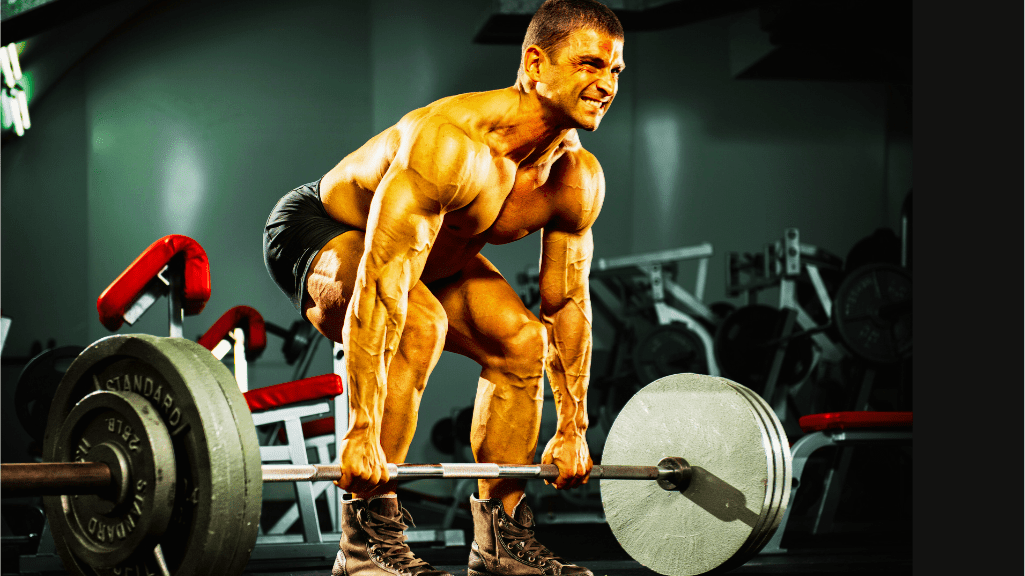
Definition of Weightlifting
At its core, weightlifting involves lifting weights to develop strength and muscle mass. This type of training is often broken down into different categories, including bodybuilding, powerlifting, and Olympic lifting, each with its own specific focus and approach.
Bodybuilding emphasizes hypertrophy, or the increase in muscle size, while powerlifting focuses on lifting heavy weights for low repetitions to maximize strength. Olympic lifting, on the other hand, involves explosive, dynamic movements that require skill and precision. Regardless of the type, weightlifting plays a crucial role in building muscle, improving strength, and enhancing athletic performance.
Types of Weightlifting
There are several types of weightlifting, each with its own unique focus and benefits.
- Bodybuilding: This form of weightlifting focuses primarily on muscle hypertrophy, or the growth of muscle tissue. Bodybuilders aim to achieve a specific physique by increasing muscle size and definition through a combination of heavy lifting, isolation exercises, and strict dieting. The benefits of weightlifting for bodybuilding include improved muscle tone, increased metabolism, and enhanced body symmetry.
- Powerlifting: Powerlifting involves performing the squat, bench press, and deadlift with maximum weight for lower repetitions. This style of weightlifting is focused on raw strength and performance, with the goal of lifting the heaviest possible loads. The benefits of weightlifting for powerlifting include greater overall strength and improved performance in competitive strength sports.
- Olympic Lifting: Olympic weightlifting consists of two primary lifts: the snatch and the clean-and-jerk. These movements require explosive power, balance, and coordination. Olympic lifters train to master these complex, dynamic lifts, often incorporating accessories such as front squats, snatch pulls, and overhead presses. The benefits of weightlifting for Olympic lifting are improved explosive strength, mobility, and technique.
Brief History of Weightlifting
The history of weightlifting dates back to ancient times, where strength and physical power were celebrated through feats such as stone lifting and manual labor. In ancient Greece, athletes competed in events such as the “Halteras,” which involved lifting heavy stones or other objects for distance and height.
In modern times, weightlifting has evolved significantly. The development of structured training programs and equipment, such as barbells and dumbbells, allowed for more controlled and systematic strength training. By the 20th century, weightlifting became a key component of fitness culture, embraced by athletes, bodybuilders, and those looking to improve overall physical health.
Today, weightlifting is a staple in gyms worldwide, with structured routines and competitions that highlight the benefits of lifting weights for strength, athletic performance, and general well-being.
Examples of Weightlifting Workouts
Weightlifting workouts can be highly varied depending on individual goals. Here are some common examples:
- Barbell Squats: A foundational lift that targets the lower body, particularly the quads, hamstrings, glutes, and core. Barbell squats are essential for developing leg strength and stability.
- Split Training: This involves breaking down workouts into specific muscle groups, such as “chest day” or “back day.” Split training allows for focused sessions on particular areas, maximizing recovery and hypertrophy.
The benefits of weightlifting are numerous, from increased muscle mass and strength to improved bone density and joint health. Weightlifting not only helps build a strong, functional body but also boosts confidence and mental resilience.
Benefits of Calisthenics vs Weightlifting: Exploring the Key Benefits of Calisthenics
Calisthenics offers a wide range of benefits that make it a popular choice for fitness enthusiasts. Whether you’re looking for a cost-effective workout solution, improved functional strength, or enhanced mobility, the benefits of calisthenics vs weightlifting are numerous and cater to various fitness goals. Let’s explore some of the key advantages of incorporating calisthenics into your fitness routine.
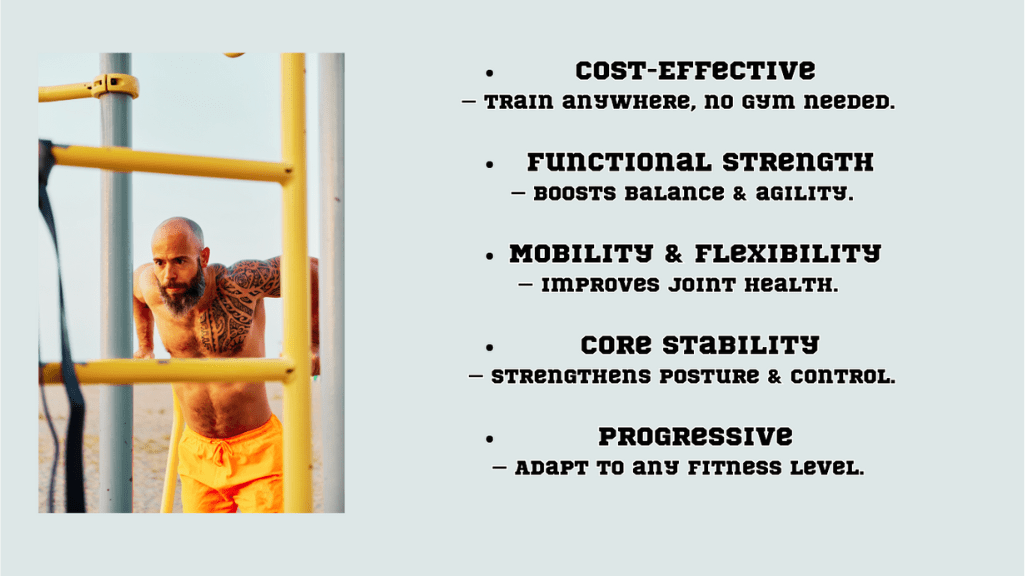
1. Cost-Effective and Accessible
- No need for gym memberships or fancy equipment
- Can be done anywhere – at home, in a park, or even while traveling
One of the most appealing aspects of calisthenics is its affordability and accessibility. Unlike weightlifting, which often requires gym memberships or specialized equipment, calisthenics can be performed anywhere—whether you’re at home, in a park, or even while traveling. This flexibility makes it an ideal option for those who prefer working out on a budget or in convenient, easily accessible locations.
The benefits of calisthenics lie in its simplicity. You don’t need expensive machines or a fully-equipped gym to see results. Bodyweight exercises such as push-ups, pull-ups, squats, and planks are all you need to get started. This means that even beginners can dive into a full workout routine without worrying about costly equipment or gym fees.
2. Builds Functional Strength
- Mimics real-world movements (pushing, pulling, squatting)
- Improves balance, coordination, and agility
Calisthenics focuses on movements that mimic real-world activities—pushing, pulling, squatting, and carrying objects. These movements not only improve your strength but also enhance your functional ability to perform daily tasks with ease. The benefits of calisthenics go beyond building isolated muscle groups; they engage multiple muscle groups simultaneously for a more balanced, functional approach to fitness.
For example, a push-up works the chest, triceps, shoulders, and core at the same time. This multi-joint movement translates into improved balance, coordination, and agility, making it easier to perform tasks like lifting groceries, playing sports, or maintaining proper posture throughout the day.
3. Enhances Mobility and Flexibility
- Dynamic movements and stretches
- Improves joint health and range of motion
Incorporating dynamic movements and stretches in calisthenics greatly improves mobility and flexibility. Exercises like bodyweight squats, lunges, and dynamic planks help maintain joint health and increase your range of motion. Unlike weightlifting, which often focuses on static positions, calisthenics encourages fluid, continuous movement, which supports a broader range of motion.
The benefits of calisthenics extend to injury prevention as well. By improving flexibility, your muscles and joints become less prone to strain and injury, allowing for a healthier and more sustainable fitness journey. Additionally, stretching exercises like forward folds and side bends ensure that your body stays limber and agile over time.
4. Engages Core Stability
- Almost every calisthenics move activates the core
- Better posture and stability
One of the standout features of calisthenics is how it actively engages the core in nearly every exercise. From simple movements like planks to more advanced exercises like handstands, every calisthenics movement requires core stability to maintain balance and control. This makes the benefits of calisthenics particularly valuable for improving overall core strength and stability, which is essential for good posture and functional movement.
5. Progressive and Customizable
- Adjust difficulty by changing leverage (e.g., knee push-ups to full push-ups)
- Can lead to advanced skills (e.g., handstands, planches, front levers)
Calisthenics is progressive and easily customizable to meet individual fitness levels and goals. You can start with basic exercises and gradually increase intensity by adjusting leverage or adding variations. For instance, knee push-ups can progress into full push-ups, and basic pull-ups can evolve into muscle-ups or more complex movements.
The benefits of calisthenics also include the ability to work towards advanced skills such as handstands, planches, or front levers. These more advanced movements challenge both strength and balance, making calisthenics an excellent way to continue progressing as you master more complex exercises.
Benefits of Weightlifting vs Calisthenics: Exploring the Benefits of Weightlifting
Weightlifting is a powerful form of strength training that offers numerous benefits for both beginners and advanced lifters. Whether your goal is to build maximum strength, promote muscle hypertrophy, or improve overall fitness, the benefits of weightlifting vs calisthenics are significant and worth exploring. Let’s dive into the key advantages of incorporating weightlifting into your fitness routine.
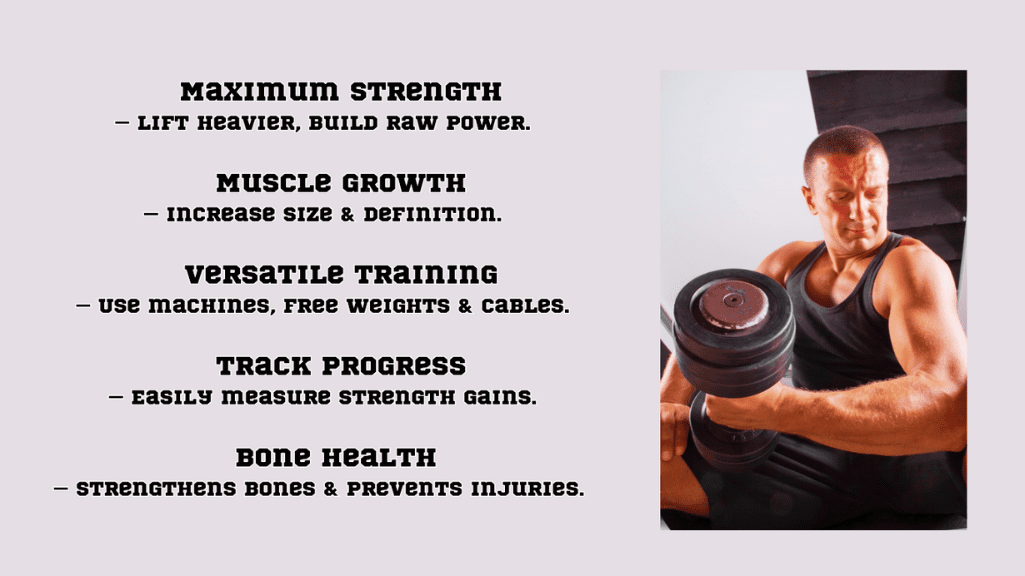
1. Builds Maximum Strength
- External weights allow for targeted, heavy-load training
- Especially effective for building raw strength in specific muscles
One of the primary benefits of weightlifting is its ability to build maximum strength. Using external weights such as dumbbells, barbells, and machines allows lifters to perform heavy-load exercises that target specific muscle groups. This focused, high-resistance training is ideal for developing raw power and strength. Whether it’s lifting heavy squats or deadlifts, weightlifting provides a controlled environment where strength can be progressively built over time.
By progressively increasing the weight, lifters can push their limits and achieve results faster compared to other forms of training. The benefits of weightlifting include stronger muscles and greater overall physical performance.
2. Promotes Muscle Hypertrophy
- Ideal for growing muscle size
- Achieving a more defined physique
Another significant benefit of weightlifting is its ability to promote muscle hypertrophy, or the growth of muscle size. This is achieved through the use of heavy weights and higher repetitions, which stimulate muscle fibers to adapt and grow. Whether you’re aiming for a more defined physique or looking to bulk up, weightlifting offers a structured path to muscle development.
Exercises like barbell curls, bench presses, and shoulder presses specifically target different muscle groups, leading to a more sculpted and defined appearance. The benefits of weightlifting in terms of hypertrophy are unmatched in their ability to create noticeable gains in muscle size and strength.
3. Versatility with Equipment
- Use of machines, free weights, or cables
- For isolated or compound movements
Weightlifting is incredibly versatile, offering a wide range of options for exercises through various equipment. Whether you prefer machines, free weights, or cables, weightlifting allows for a variety of movements to suit your fitness goals. Compound movements like squats, deadlifts, and bench presses engage multiple muscle groups, while isolation exercises focus on specific muscles for targeted development.
The benefits of weightlifting in terms of versatility ensure that you can customize your training to meet specific goals—whether that’s increasing overall strength, improving balance, or enhancing muscle definition. This flexibility makes weightlifting an effective option for anyone, from beginners to advanced athletes.
4. Helps Track Progress
- Easy to measure improvements by increasing weight over time
One of the key benefits of weightlifting is its ability to track progress effectively. With a straightforward method of progressively increasing weights, lifters can easily see their improvements in strength and muscle development. Whether it’s adding five pounds to a bench press or increasing the number of repetitions, weightlifting provides tangible results that are easy to monitor.
This quantifiable aspect of weightlifting motivates individuals to push harder and achieve their fitness goals. The benefits of weightlifting are evident in measurable milestones, giving lifters a sense of accomplishment as they continually improve.
5. Bone Density and Injury Prevention
- Resistance training strengthens bones
- Reduces injury risk with proper form
Weightlifting is also beneficial for enhancing bone density and reducing the risk of injuries. Resistance training, particularly with heavy weights, stimulates bone growth and density, which is crucial as you age. Stronger bones can help prevent fractures and reduce the risk of osteoporosis.
Additionally, when performed with proper form, weightlifting helps minimize injury risks. Exercises such as deadlifts and squats, when done correctly, engage muscles and joints in ways that promote joint stability and prevent strain or injury. The benefits of weightlifting extend beyond just building muscle—they create a stronger, more resilient body that can handle daily physical demands safely.
Benefits of Calisthenics vs Weightlifting: A Side-by-Side Comparison
When it comes to fitness, two popular training methods—calisthenics vs weightlifting—offer distinct benefits and challenges. While both approaches build strength and improve overall fitness, they cater to different goals and preferences. Below, we’ll break down a comparison of key factors such as cost, space, progression, goals, and injury risk to provide a clearer understanding of which might be the right fit for you.
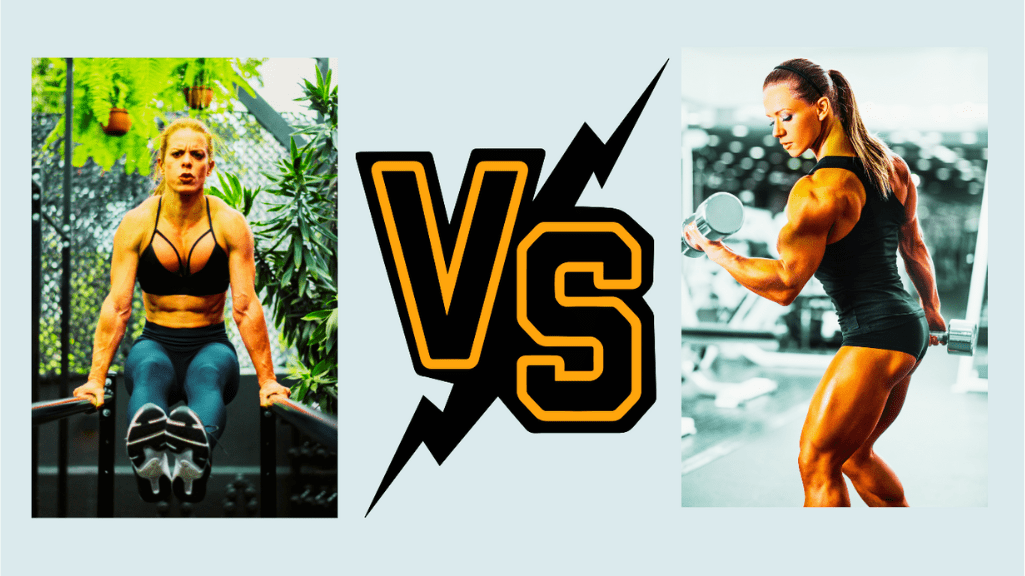
1. Cost
- Calisthenics is free; weightlifting often requires a gym or equipment
One of the most significant differences between calisthenics vs weightlifting is the cost. Calisthenics is entirely free and requires no special equipment or gym membership. Bodyweight exercises like push-ups, pull-ups, squats, and planks can be performed anywhere, whether it’s at home, in a park, or while traveling. On the other hand, weightlifting typically demands access to a gym or the purchase of equipment such as dumbbells, barbells, or machines, which can add up in cost over time.
For those seeking a budget-friendly fitness option, calisthenics proves to be the more accessible choice. However, weightlifting offers a more advanced setup for those looking for a more structured environment with heavier loads.
2. Space
- Calisthenics can be done in small spaces; weightlifting needs equipment
Another factor to consider is space. Calisthenics requires minimal space and can be performed in virtually any location. Whether it’s a small bedroom, a park, or even a hotel room, bodyweight exercises require very little room to execute. On the flip side, weightlifting demands a dedicated space for equipment like benches, racks, and weights, which can be cumbersome to store and set up in confined spaces.
If you’re someone who values convenience and the ability to work out in various environments, calisthenics offers a significant advantage. However, if you prefer a gym-like experience with specialized equipment, weightlifting provides a more comprehensive setup.
3. Progression
- Calisthenics requires creativity to increase difficulty; weightlifting uses heavier weights
Calisthenics vs weightlifting also differ in terms of progression. While weightlifting focuses heavily on increasing the weight being lifted, calisthenics involves adjusting the difficulty of bodyweight exercises by modifying leverage, tempo, or repetitions. For example, simple push-ups can evolve into single-arm push-ups or decline push-ups to challenge the muscles further.
With weightlifting, adding heavier weights directly increases resistance, offering a clear and measurable way to track progress. In contrast, calisthenics requires creativity and variety in exercise selection to continue building strength and muscle over time. The ability to shift focus to different types of movements—static holds, dynamic variations, or balance-based exercises—makes calisthenics a versatile method for progression.
4. Goals
- Calisthenics focuses on functional strength, agility, and body control
- Weightlifting targets muscle mass, raw strength, and precise targeting
When it comes to goals, calisthenics vs weightlifting caters to different types of fitness aspirations. Calisthenics emphasizes functional strength, body control, and agility. Exercises like handstands, human flags, and muscle-ups challenge coordination and flexibility, which are essential for real-world functionality and athletic performance.
In contrast, weightlifting is geared towards building muscle mass, raw strength, and precision targeting of specific muscle groups. Movements like squats, deadlifts, and bench presses allow lifters to focus on isolating certain muscles, making it ideal for bodybuilding or strength-focused goals.
5. Injury Risk
- Weightlifting has higher risk if form is poor
- Calisthenics reduces risk but requires patience for progression
Injury risk is another key point of distinction between calisthenics vs weightlifting. While both require proper form to minimize injuries, weightlifting often carries a higher risk when poor technique is used. Heavy lifts like squats or deadlifts demand precise form to avoid strain or joint issues. On the other hand, calisthenics offers a more gradual progression, reducing the risk of injury if performed with patience and proper progression.
However, the challenge in calisthenics lies in advancing gradually without rushing through movements. Exercises like planches or advanced pull-ups require time and careful practice to master, but with consistent effort, the injury risk remains manageable.
Calisthenics vs. Weightlifting: Additional Considerations
| Factor | Calisthenics | Weightlifting |
|---|---|---|
| Portability | Highly portable—train anywhere with no equipment needed. | Requires equipment, making it less travel-friendly. |
| Skill Development | Builds balance, coordination, and control through dynamic movements. | Develops isolated muscle strength and power efficiently. |
| Longevity & Joint Health | Lower impact on joints when performed correctly. | Potential for joint strain due to heavy loads, requiring proper warm-up and recovery. |
| Caloric Burn | Engages multiple muscles at once, leading to a higher calorie burn in bodyweight circuits. | Burns calories effectively, especially during heavy compound lifts. |
| Variety | Endless exercise variations with body positioning adjustments. | Progressive overload is straightforward with added weight increments. |
| Muscle Endurance vs. Strength | Improves endurance, mobility, and explosive strength. | Increases raw strength and muscle hypertrophy. |
| Best For | Those seeking functional fitness, agility, and mobility. | Individuals focusing on muscle growth, maximal strength, and bodybuilding. |
Benefits of Calisthenics vs Weightlifting: Who Should Choose Calisthenics?
When considering fitness routines, one must evaluate which approach aligns best with individual goals and lifestyles. Calisthenics vs weightlifting offers unique advantages, and understanding who should choose calisthenics can help guide fitness decisions. Whether you’re a beginner looking for a low-cost workout or someone aiming to improve functional strength and flexibility, calisthenics provides a versatile and effective option. Below, we’ll explore who should opt for calisthenics and the achievable goals it offers.
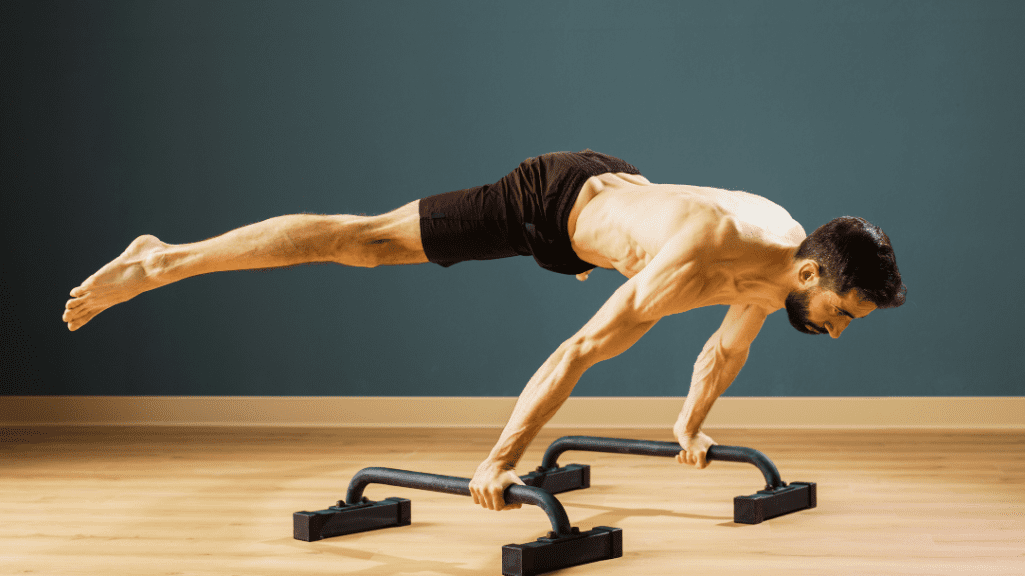
Ideal For
- Beginners who want a low-cost, approachable workout
- People aiming for functional strength, mobility, and flexibility
- Those who enjoy outdoor workouts or lack access to a gym
One of the most significant benefits of calisthenics is its suitability for a wide range of individuals, particularly beginners. Unlike weightlifting, which often requires access to a gym and equipment, calisthenics offers a straightforward, no-cost solution. Bodyweight exercises such as push-ups, pull-ups, squats, and planks can be performed anywhere—at home, in a park, or even while traveling. This makes calisthenics ideal for anyone looking for an accessible fitness option without the need for expensive equipment or gym memberships.
Additionally, individuals seeking to improve functional strength, mobility, and flexibility will find calisthenics particularly effective. Movements like yoga-inspired stretches, dynamic holds, and bodyweight variations challenge the body’s stability and coordination, ensuring that each exercise engages multiple muscle groups for a more holistic fitness approach. For those who prefer outdoor workouts or simply don’t have easy access to a gym, calisthenics is a convenient and flexible option.
Achievable Goals
- Sculpted, lean physique
- Advanced bodyweight skills (e.g., planches, handstand push-ups)
- Improved athletic performance and daily movement
Calisthenics offers a range of achievable goals, catering to individuals at every fitness level. Beginners can start with basic movements like bodyweight squats and push-ups to build foundational strength. As progress is made, individuals can work towards more advanced skills, such as handstand push-ups, muscle-ups, or even static holds like the human flag. These advanced movements showcase the versatility of calisthenics, allowing individuals to grow into increasingly challenging exercises.
For those aiming for a lean, sculpted physique, calisthenics delivers impressive results through high-rep bodyweight exercises and dynamic movements. The ability to combine strength with body control helps individuals achieve a balanced, toned look that translates to better athletic performance and improved daily functionality. Whether it’s improving posture, enhancing flexibility, or refining balance, calisthenics promotes an overall improvement in physical well-being.
Benefits of Calisthenics vs Weightlifting
Calisthenics vs weightlifting each have their own strengths, but choosing the right one depends on personal goals and preferences. While weightlifting emphasizes building raw strength and muscle mass through heavy resistance training, calisthenics focuses on functional movement, body control, and a holistic approach to fitness.
Injury risk is also an important factor to consider. While calisthenics minimizes the risk of injury by encouraging controlled, bodyweight-based movements, weightlifting can lead to higher injury risks if form is compromised or weights are lifted improperly. Therefore, beginners and those looking for lower-risk exercise will appreciate the safer progression offered by calisthenics.
Ultimately, the choice between calisthenics vs weightlifting comes down to individual fitness goals and lifestyle preferences. For those seeking flexibility, accessibility, and functional strength, calisthenics is an excellent option. Its adaptability and variety of movements make it suitable for anyone, from novices to advanced athletes.
Benefits of Calisthenics vs Weightlifting: Who Should Choose Weightlifting?
When deciding between calisthenics vs weightlifting, it’s essential to understand who might benefit most from a weightlifting-focused routine. Weightlifting offers a structured, equipment-based approach to fitness, targeting specific strength and muscle-building goals. Whether you’re an athlete looking to enhance power or someone seeking a bodybuilding physique, weightlifting provides the tools to achieve these objectives. Below, we’ll explore who should choose weightlifting and the achievable goals it offers.
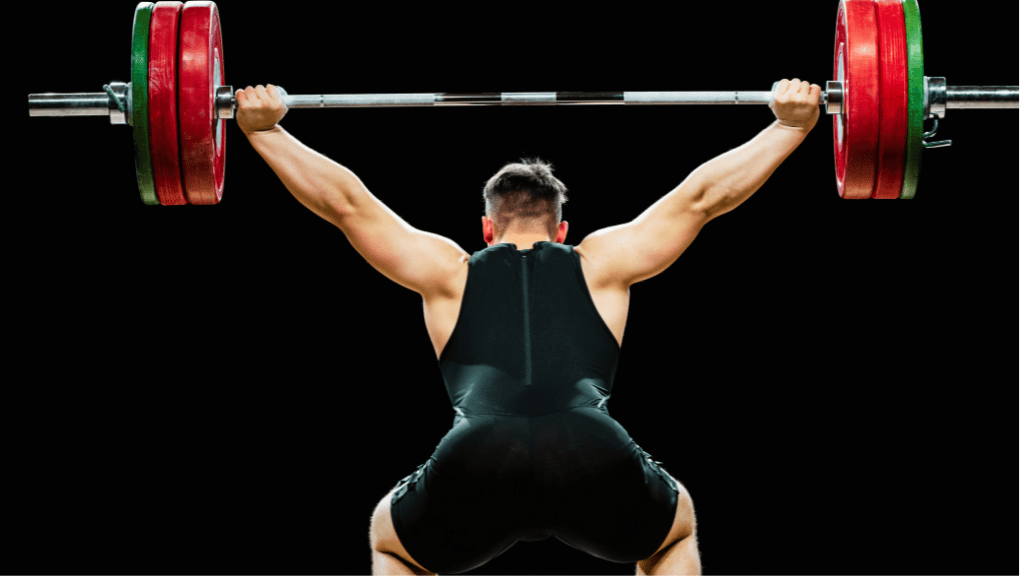
Ideal For
- People with specific muscle-building or strength goals
- Athletes focusing on explosive power or competitive lifting
- Gym-goers who enjoy structured programs
Weightlifting is perfect for individuals who have clear, targeted fitness objectives. Whether it’s building a muscular physique through bodybuilding or developing max strength for sports performance, weightlifting provides a methodical approach to achieving these results. For athletes, especially those involved in power sports or competitive lifting, weightlifting offers exercises like squats, bench presses, and deadlifts that develop explosive power and raw strength. These movements are essential for peak performance in sports such as football, weightlifting, or crossfit.
Additionally, weightlifting suits gym-goers who thrive on structured programs with set goals. Unlike calisthenics, which emphasizes bodyweight movements, weightlifting incorporates various pieces of equipment like barbells, dumbbells, and machines to provide a more focused, measurable progression. For those who enjoy seeing tangible improvements through heavier weights and precise lifts, weightlifting provides a satisfying and rewarding approach.
Achievable Goals
- Greater muscle hypertrophy (bodybuilding physique)
- Enhanced max strength and power (lifting heavier weights)
- Targeted improvements in weak muscle groups
One of the primary benefits of weightlifting vs calisthenics is its ability to drive muscle hypertrophy—the increase in muscle size. Through controlled, heavy lifts, individuals aiming for a more defined, bulkier physique can target specific muscle groups, often achieving noticeable changes in muscle shape and size. For gym-goers looking for a bodybuilder’s physique or those pursuing a symmetrical and well-defined look, weightlifting delivers efficient results.
In addition to hypertrophy, weightlifting enhances max strength and power. By progressively increasing the weight lifted, individuals can experience substantial improvements in overall strength, allowing them to lift heavier loads in compound movements. These lifts not only push the limits of muscle endurance but also challenge the nervous system to recruit more muscle fibers during each rep.
Furthermore, for those dealing with imbalances or weaknesses in certain muscle groups, weightlifting allows for targeted improvements. Through isolated movements or accessory lifts, weaker muscles can be developed alongside primary lifts, ensuring a more balanced, functional physique. This is difficult to achieve through bodyweight exercises alone, where movement patterns are more generalized.
Benefits of Weightlifting vs Calisthenics
When comparing weightlifting vs calisthenics, both offer distinct advantages. Weightlifting excels in building maximum strength, muscle mass, and power through heavy resistance training. On the other hand, calisthenics focuses more on functional movement, body control, and versatility with minimal equipment.
Another critical factor is injury risk. While weightlifting can pose a higher risk if proper technique isn’t followed, the use of heavier weights requires more focus on form and safety. Conversely, calisthenics tends to minimize injury risk through bodyweight exercises that encourage controlled movement and balance.
Ultimately, choosing between weightlifting vs calisthenics depends on individual preferences, goals, and lifestyle. Those who enjoy structured, goal-oriented fitness routines, along with a focus on measurable improvements, will likely benefit most from weightlifting.
Benefits of Calisthenics vs Weightlifting: Combining Both for Maximum Results
When considering benefits of calisthenics vs weightlifting, many fitness enthusiasts are beginning to recognize the value of integrating both into their training routines. Combining calisthenics and weightlifting can maximize results by targeting different aspects of fitness, ensuring a well-rounded approach to strength, mobility, and overall performance. Whether you’re an athlete looking for enhanced functional movement or someone aiming for a balanced, comprehensive fitness regime, blending these two styles can deliver exceptional outcomes. Below, we explore how combining calisthenics vs weightlifting can provide the best of both worlds.
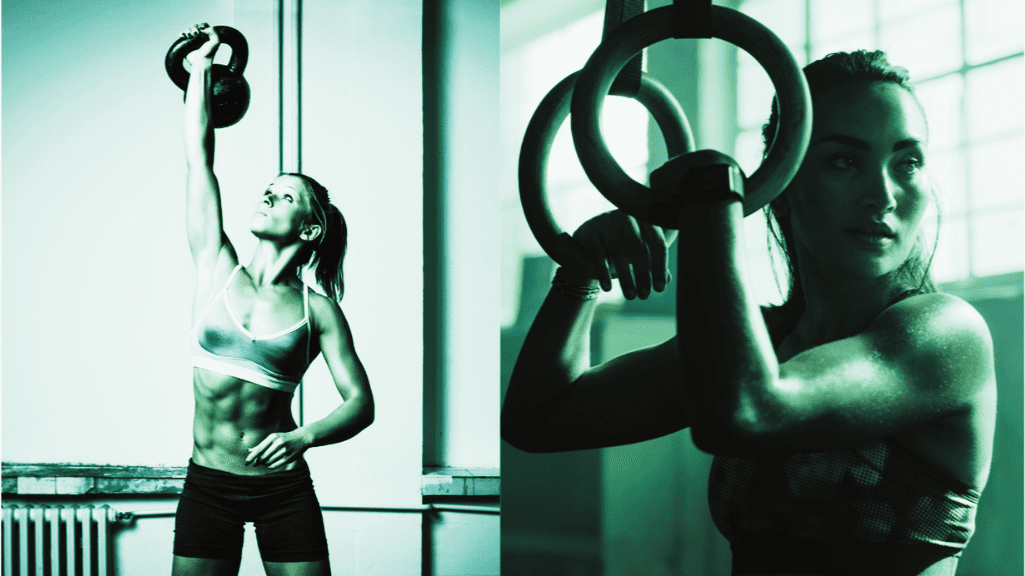
Benefits of Calisthenics vs Weightlifting:Why Combine Calisthenics and Weightlifting?
Combining calisthenics and weightlifting provides a balanced approach to fitness. While weightlifting focuses on building raw strength and muscle mass through external resistance, calisthenics emphasizes functional movements and body control with minimal equipment. By incorporating both, you can achieve a harmonious blend of strength, flexibility, and overall functional performance.
Using calisthenics for specific goals, such as core training, endurance, and bodyweight movements, alongside weightlifting for maximum strength-building, ensures that you’re covering a broad spectrum of physical fitness. For example, weightlifting can help develop muscular size and power, while calisthenics enhances mobility, coordination, and balance. This combination allows for a more complete, sustainable approach to fitness.
Examples of Combining Calisthenics and Weightlifting
- Use calisthenics for warm-ups or core training
- Weightlifting for strength-building, then calisthenics for functional mobility
One effective way to combine calisthenics and weightlifting is by integrating bodyweight movements into your warm-ups or cool-down routines. For instance, performing dynamic stretches or bodyweight exercises before weightlifting sessions prepares the body for heavy lifts and improves flexibility. This reduces injury risk and enhances performance during heavy compound movements like squats, deadlifts, or bench presses.
After completing a weightlifting session, adding calisthenics exercises can be beneficial for cooling down and improving mobility. Exercises such as push-ups, planks, or leg raises can increase blood flow to muscles and improve joint health. Moreover, incorporating calisthenics movements like L-sits or handstands strengthens stabilizer muscles, enhancing overall control and body awareness.
Benefits of Combining Calisthenics and Weightlifting
- Maximized strength and functional movement
- Enhanced mobility, balance, and endurance
- Reduced injury risk
- Increased variety and workout enjoyment
Combining calisthenics vs weightlifting offers a variety of physical benefits. By using external weights to lift heavier loads, you’ll develop maximum strength and muscle hypertrophy. However, blending this with calisthenics ensures that mobility and core stability aren’t neglected. Strength is great, but without functional control and flexibility, performance can suffer.
Furthermore, blending these approaches allows for a more comprehensive assessment of physical development. You’ll track progress not only in terms of lifting heavier weights but also in mastering difficult bodyweight movements. This holistic method supports overall athleticism, making you better prepared for real-life activities, sports, or other fitness challenges.
Key Takeaways
- Combining calisthenics and weightlifting ensures balanced fitness.
- Weightlifting builds raw strength, while calisthenics improves mobility and stability.
- Blending both approaches enhances injury prevention and overall performance.
By combining calisthenics and weightlifting, you’re optimizing your fitness journey, embracing both strength development and functional movement. Whether you’re a beginner or a seasoned athlete, this method allows for growth across multiple domains, delivering long-term, sustainable fitness results.
Debunking Myths: Benefits of Calisthenics vs Weightlifting
When it comes to fitness, there are many misconceptions surrounding both calisthenics and weightlifting. These myths often discourage people from exploring one or both forms of training, even though each offers unique benefits of calisthenics vs weightlifting. To help clear the air, let’s address some of the most common myths about calisthenics vs weightlifting and provide evidence to dispel them.
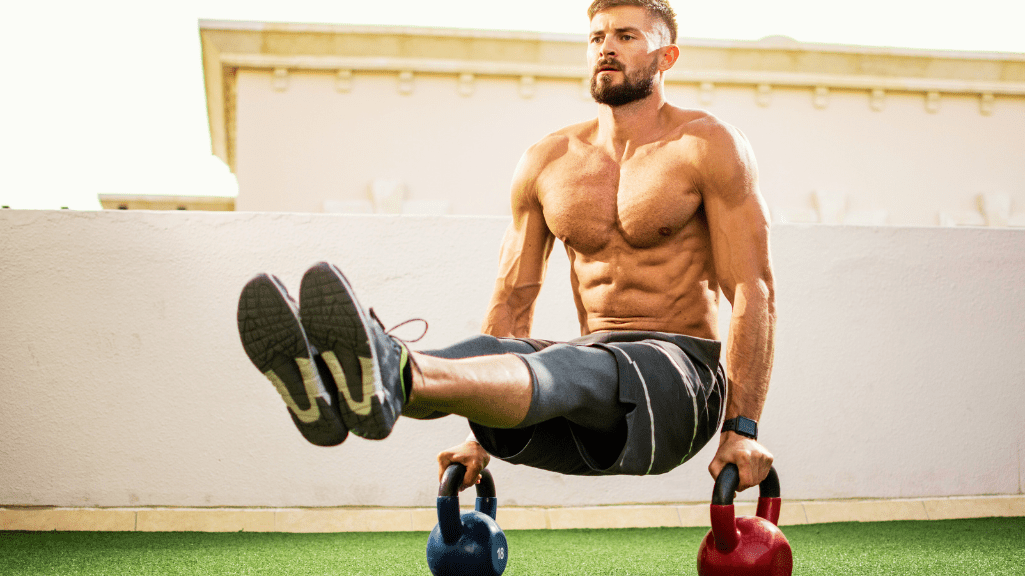
Myth 1: You Can’t Build Muscle with Calisthenics
- Many believe that calisthenics isn’t effective for building muscle because it relies solely on bodyweight exercises.
- However, exercises like push-ups, pull-ups, and squats can effectively build muscle mass through progressive overload.
- Advanced calisthenics movements, such as muscle-ups and handstands, require significant muscle development.
- Consistent training with bodyweight exercises can lead to substantial muscle hypertrophy.
Myth 2: Weightlifting Makes You Bulky and Inflexible
- A common misconception is that weightlifting leads to a bulky, inflexible physique.
- While weightlifting can result in muscle hypertrophy, mobility and flexibility can be maintained through proper training techniques.
- Accessory lifts and stretches can complement weightlifting to ensure flexibility isn’t sacrificed for size.
- Lifters can develop strength while keeping mobility intact, debunking the myth that lifting makes you stiff.
Myth 3: Calisthenics Is Not Suitable for Strength Building
- Another myth is that calisthenics cannot match weightlifting in terms of raw strength development.
- Calisthenics exercises like pull-ups, dips, and bodyweight squats challenge muscles through functional movements.
- These exercises build strength that is transferable to real-world activities, making it highly practical.
- Lifters who focus solely on isolated movements may miss out on the functional gains provided by calisthenic training.
Myth 4: Weightlifting Is Only for Competitive Athletes
- Some believe that weightlifting is only for elite athletes or bodybuilders.
- However, weightlifting offers numerous benefits of calisthenics vs weightlifting for individuals at all fitness levels.
- It can be tailored to meet a variety of fitness goals, including strength, endurance, and athletic performance.
- From beginners to experienced gym-goers, weightlifting can be adapted to suit different needs and abilities.
Maximizing Fitness: Benefits of Calisthenics vs Weightlifting
Throughout this article, we’ve explored the benefits of calisthenics vs weightlifting and delved into what makes each approach unique. Both have their own strengths, and understanding these differences can help you make a more informed decision about which method suits your fitness goals best. Below are the key points we’ve covered, highlighting why each made its way into our discussion:
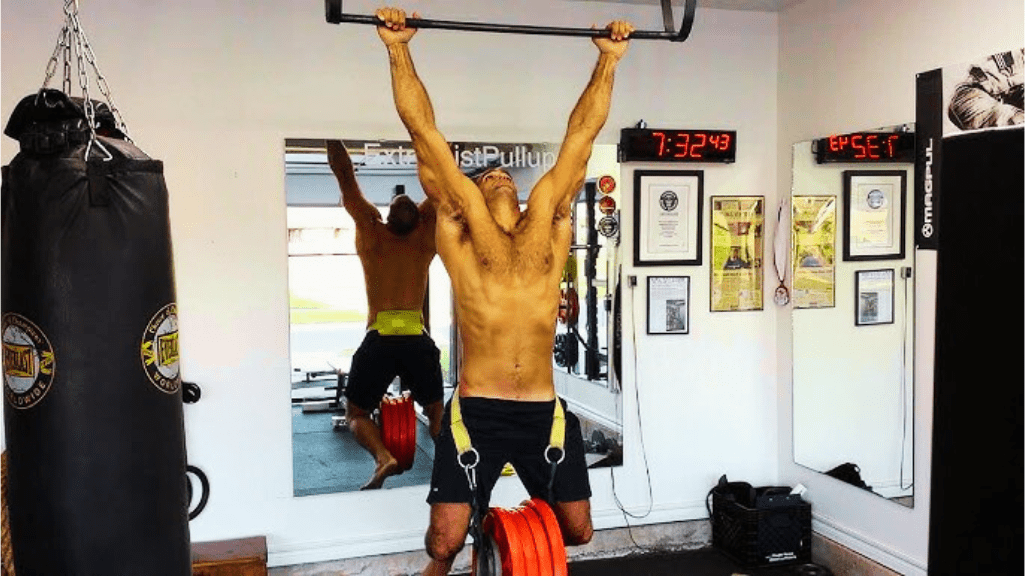
1. Cost-Effectiveness and Accessibility
- Calisthenics is completely free and requires no equipment, making it accessible to everyone, regardless of budget or location.
- Weightlifting often requires access to a gym or external weights, which can be more costly and less convenient.
- This distinction plays a major role when considering long-term sustainability in your fitness journey.
2. Functional Strength and Mobility
- Calisthenics focuses on bodyweight exercises that improve functional strength—enhancing movements used in daily life.
- It also promotes mobility and flexibility, ensuring better joint health and balance.
- On the other hand, weightlifting provides raw strength and muscle hypertrophy, targeting specific muscle groups for growth and definition.
3. Progression and Customization
- Calisthenics offers progressive overload by adjusting leverage, allowing individuals to continually challenge themselves as they improve.
- Weightlifting utilizes heavier weights and structured programs to track measurable progress, whether in strength or muscle mass.
- Both methods cater to those who seek structured growth, but they differ in how that progression is achieved.
4. Injury Prevention and Risk Management
- Calisthenics has a lower risk of injury compared to weightlifting, especially when executed with proper form.
- However, weightlifting requires more attention to form due to the heavier loads, which can reduce injury risk when done correctly.
- Understanding the benefits of calisthenics vs weightlifting helps individuals manage and reduce injury risks, regardless of the chosen method.
5. Versatility and Accessibility
- Calisthenics can be performed anywhere, whether at home, in a park, or while traveling, due to its minimal equipment needs.
- Weightlifting is more equipment-dependent, requiring access to a gym or a fully equipped home gym, making it less flexible in terms of location.
- These differences highlight why both methods have their unique appeal based on lifestyle preferences.
The best workout is the one you’ll stick to. Whether you choose calisthenics, weightlifting, or a mix of both, the important thing is to move your body and stay consistent!
Benefits of Calisthenics vs Weightlifting: FAQ Section
1. Can I build muscle with calisthenics?
Yes, calisthenics can effectively build muscle mass through progressive overload and advanced movements.
2. Is weightlifting dangerous for beginners?
Weightlifting can be safe if proper form is maintained and weights are progressively increased over time.
3. Which is better for flexibility: calisthenics or weightlifting?
Calisthenics tends to improve flexibility more due to its focus on bodyweight movements.
4. Can I combine calisthenics and weightlifting?
Yes, combining both methods can provide a well-rounded fitness routine that addresses strength, mobility, and functional movement.
5. Is calisthenics suitable for athletes?
Absolutely! Calisthenics improves functional strength and agility, making it ideal for athletes.
6. What are some common mistakes in weightlifting?
Common mistakes include using poor form, lifting weights that are too heavy, and neglecting accessory lifts for balance.
7. How long does it take to see results in calisthenics?
Results depend on consistency and progression, but noticeable improvements can be seen within a few months of regular practice.
8. Is weightlifting only for bodybuilders?
No, weightlifting can be tailored to various fitness goals, from general strength to sports performance.
9. What are the best calisthenics exercises for beginners?
Beginner-friendly exercises include push-ups, air squats, and planks.
10. Can I switch between calisthenics and weightlifting?
Yes, switching between the two can offer a balanced and effective fitness approach.

